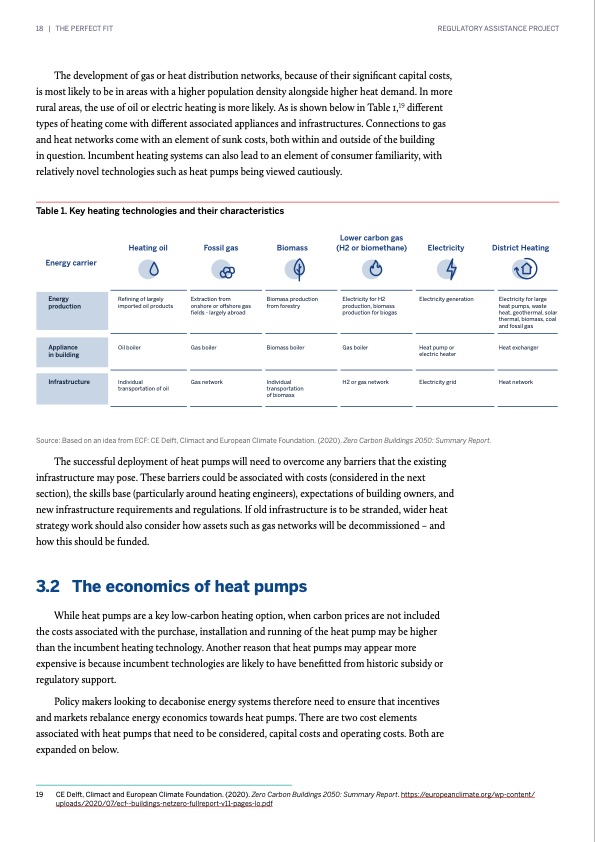
PDF Publication Title:
Text from PDF Page: 018
18 | THE PERFECT FIT REGULATORY ASSISTANCE PROJECT The development of gas or heat distribution networks, because of their significant capital costs, is most likely to be in areas with a higher population density alongside higher heat demand. In more rural areas, the use of oil or electric heating is more likely. As is shown below in Table 1,19 different types of heating come with different associated appliances and infrastructures. Connections to gas and heat networks come with an element of sunk costs, both within and outside of the building in question. Incumbent heating systems can also lead to an element of consumer familiarity, with relatively novel technologies such as heat pumps being viewed cautiously. Table 1. Key heating technologies and their characteristics Energy carrier Heating oil Fossil gas Biomass Lower carbon gas (H2 or biomethane) Electricity District Heating Electricity for large heat pumps, waste heat, geothermal, solar thermal, biomass, coal and fossil gas Heat exchanger Heat network Energy production Infrastructure Refining of largely imported oil products Oil boiler Individual transportation of oil Extraction from onshore or offshore gas fields - largely abroad Gas boiler Gas network Biomass production from forestry Biomass boiler Individual transportation of biomass Electricity for H2 production, biomass production for biogas Gas boiler Electricity generation Appliance in building Heat pump or electric heater H2 or gas network Electricity grid Source: Based on an idea from ECF: CE Delft, Climact and European Climate Foundation. (2020). Zero Carbon Buildings 2050: Summary Report. The successful deployment of heat pumps will need to overcome any barriers that the existing infrastructure may pose. These barriers could be associated with costs (considered in the next section), the skills base (particularly around heating engineers), expectations of building owners, and new infrastructure requirements and regulations. If old infrastructure is to be stranded, wider heat strategy work should also consider how assets such as gas networks will be decommissioned – and how this should be funded. 3.2 The economics of heat pumps While heat pumps are a key low-carbon heating option, when carbon prices are not included the costs associated with the purchase, installation and running of the heat pump may be higher than the incumbent heating technology. Another reason that heat pumps may appear more expensive is because incumbent technologies are likely to have benefitted from historic subsidy or regulatory support. Policy makers looking to decabonise energy systems therefore need to ensure that incentives and markets rebalance energy economics towards heat pumps. There are two cost elements associated with heat pumps that need to be considered, capital costs and operating costs. Both are expanded on below. 19 CE Delft, Climact and European Climate Foundation. (2020). Zero Carbon Buildings 2050: Summary Report. https://europeanclimate.org/wp-content/ uploads/2020/07/ecf--buildings-netzero-fullreport-v11-pages-lo.pdfPDF Image | RAP Perfect Fit Heat Pump

PDF Search Title:
RAP Perfect Fit Heat PumpOriginal File Name Searched:
RAP-heat-pump-report-FINAL_2022_03.pdfDIY PDF Search: Google It | Yahoo | Bing
CO2 Organic Rankine Cycle Experimenter Platform The supercritical CO2 phase change system is both a heat pump and organic rankine cycle which can be used for those purposes and as a supercritical extractor for advanced subcritical and supercritical extraction technology. Uses include producing nanoparticles, precious metal CO2 extraction, lithium battery recycling, and other applications... More Info
Heat Pumps CO2 ORC Heat Pump System Platform More Info
| CONTACT TEL: 608-238-6001 Email: greg@infinityturbine.com | RSS | AMP |